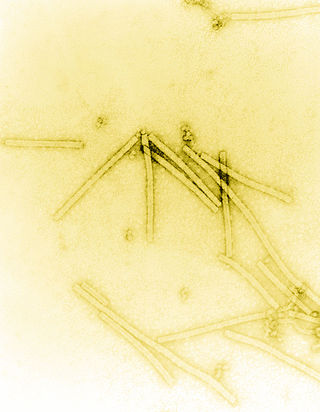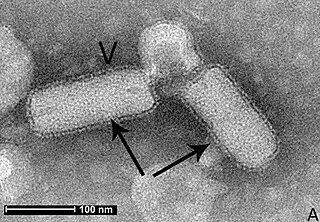Virus classification is the process of naming viruses and placing them into a taxonomic system similar to the classification systems used for cellular organisms.

Tobacco mosaic virus (TMV) is a positive-sense single-stranded RNA virus species in the genus Tobamovirus that infects a wide range of plants, especially tobacco and other members of the family Solanaceae. The infection causes characteristic patterns, such as "mosaic"-like mottling and discoloration on the leaves. TMV was the first virus to be discovered. Although it was known from the late 19th century that a non-bacterial infectious disease was damaging tobacco crops, it was not until 1930 that the infectious agent was determined to be a virus. It is the first pathogen identified as a virus. The virus was crystallised by Wendell Meredith Stanley. It has a similar size to the largest synthetic molecule, known as PG5.
Tenuivirus is a plant virus genus belonging to Phenuiviridae family in the order Bunyavirales. These plant viruses cause diseases in their host plants. Typical symptoms are chlorotic stripes on the affected leaves. This group of viruses make viral inclusions in infected cells which can be used to diagnose infection.

Cowpea mosaic virus (CPMV) is a non-enveloped plant virus of the comovirus group. Infection of a susceptible cowpea leaf causes a "mosaic" pattern in the leaf, and results in high virus yields (1-2 g/kg). Its genome consists of 2 molecules of positive-sense RNA (RNA-1 and RNA-2) which are separately encapsidated. Both RNA1 and RNA2 have a VPg (virus genome-linked protein) at the 5'end, and polyadenylation at the 3' end. Genomic RNA1 and RNA2 are expressed by a polyprotein processing strategy. RNA1 encodes helicase, VPg, protease and RdRp. RNA2 encodes movement protein and coat protein. The virus particles are 28 nm in diameter and contain 60 copies each of a Large (L) and Small (S) coat protein. The structure is well characterised to atomic resolution, and the viral particles are thermostable. The identification of the virus is attributed to Lister and Thresh in 1955, but it is now known as a variant of the Sunn-hemp mosaic virus.

Maize streak virus (MSV) is a virus primarily known for causing maize streak disease (MSD) in its major host, and which also infects over 80 wild and domesticated grasses. It is an insect-transmitted pathogen of maize in the genus Mastrevirus of the family Geminiviridae that is endemic in sub-Saharan Africa and neighbouring Indian Ocean island territories such as Madagascar, Mauritius and La Reunion. The A-strain of MSV (MSV-A) causes sporadic maize streak disease epidemics throughout the maize-growing regions of Africa. MSV was first described by the South African entomologist Claude Fuller who referred to it in a 1901 report as "mealie variegation".
African cassava mosaic virus is a plant pathogenic virus of the family Geminiviridae that may cause either a mosaic appearance to plant leaves, or chlorosis. In Manihot esculenta (cassava), the most produced food crop in Africa, the virus causes severe mosaic. Cassava is a staple food crop in many places throughout the tropics and subtropics as a source of carbohydrates, but the transmission and severity of disease for cassava in Africa is greatest with ACMV.
Arabis mosaic virus is a viral plant pathogen that is known to infect multiple hosts. The pathogen, commonly referred to as ArMV, is from the family Secoviridae, and it causes yellow dwarf of raspberry and is one of the causes of mosaic of rhubarb. Arabis mosaic virus infects multiple hosts, including strawberries, hops, hemp, grape, geraniums, raspberries, sugar beets, celery, horseradish, lilac, peach, and lettuces.
Cytorhabdovirus hordei is a plant pathogenic virus.
Cassava vein mosaic virus (CsVMV) is a plant pathogenic virus of the family Caulimoviridae.
Clover yellow mosaic virus (ClYMV) is a plant pathogenic virus in the genus Potexvirus and the virus family Alphaflexiviridae. Its flexuous rod-shaped particles measure about 539 nm in length.

Cucumber mosaic virus (CMV) is a plant pathogenic virus in the family Bromoviridae. This virus has a worldwide distribution and a very wide host range, having the reputation of the widest host range of any known plant virus. It can be transmitted from plant to plant both mechanically by sap and by aphids in a stylet-borne fashion. It can also be transmitted in seeds and by the parasitic weeds, Cuscuta sp. (dodder).
European striate mosaic virus (EWSMV) is a plant pathogenic virus of the genus Tenuivirus.
Petunia asteroid mosaic virus (PetAMV) is a plant pathogenic virus of the family Tombusviridae, infecting grapevine.

Sugarcane mosaic virus (SCMV) is a plant pathogenic virus of the family Potyviridae. The virus was first noticed in Puerto Rico in 1916 and spread rapidly throughout the southern United States in the early 1920s. SCMV is of great concern because of the high economic impact it has on sugarcane and maize.

Carlavirus, formerly known as the "Carnation latent virus group", is a genus of viruses in the order Tymovirales, in the family Betaflexiviridae. Plants serve as natural hosts. There are 53 species in this genus. Diseases associated with this genus include: mosaic and ringspot symptoms.

Kunjin virus (KUNV) is a zoonotic virus of the family Flaviviridae and the genus Flavivirus. It is a subtype of West Nile virus endemic to Oceania.

Betaflexiviridae is a family of viruses in the order Tymovirales. Plants and fungi serve as natural hosts. There are 108 species in this family, assigned to 13 genera in two subfamilies. Diseases associated with this family include mosaic and ringspot symptoms.
Abaca bunchy top virus (ABTV) is a pathogenic plant virus of the family Nanoviridae. ABTV has been isolated from both abacá (Musa textilis) and banana (Musa sp.). ABTV has many similarities to banana bunchy top virus (BBTV) but is both genetically and serologically distinct in that it lacks two open reading frames found in BBTV's genome. ATBV's genome contains six circular components, each of which are 1,000-1,500 base pairs in length.

Cytorhabdovirus is a genus of viruses in the family Rhabdoviridae, order Mononegavirales. Plants serve as natural hosts.
Mastrevirus is a genus of ssDNA viruses, in the family Geminiviridae. Mostly monocotyledonous plants serve as natural hosts. They are vectored by planthoppers. There are 45 species in this genus. Diseases associated with this genus include: maize streak virus: maize streak disease (MSD).







